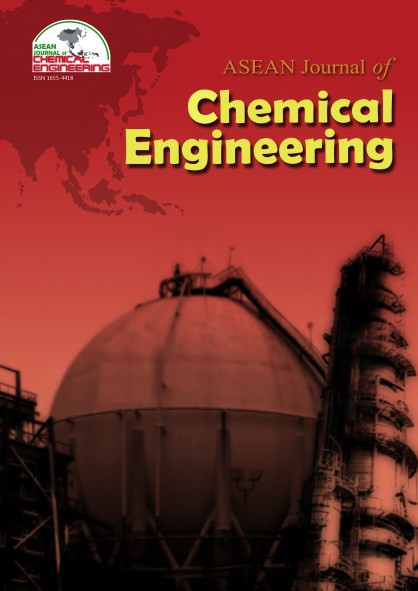Simulation on the Breakthrough Curve During CO2 Adsorption from Biogas in a Fixed Bed Column
Abstract
Separation of CO2 gas from the biogas can be accomplished by adsorption process. An adsorbent has a maximum capacity, so the adsorbent will eventually be saturated at a certain time. Therefore, it is necessary to simulate the adsorption mass transfer to produce a breakthrough curve. The breakthrough curve from the simulation of adsorption mass transfer was validated with the experimental data. The research was conducted using variations in temperature and pressure. The mass transfer simulation was solved using the finite difference method. The adsorbent used in this research was 13X zeolite and the biogas was obtained from cow dung waste. Convergent curves can be obtained in numerical simulations as breakthrough curves. This research shows that adsorption should occur at low temperatures and high pressure. Column height and flow velocity also influence the breakthrough time. The comparison of the simulated breakthrough time with experimental data is not much different with R2 0.9969. The striking difference is in the adsorption zone with average relative error (ARE) values ranging from 9.57% to 20.49%. From the results of entropy, enthalpy, and Gibbs free energy calculations, the biogas adsorption research on the 13x zeolite column is an exothermic and spontaneous process
References
Al Kindi, H., Fadillah, A.K., Yuliana, I., Hartulistiyoso, E., Salundik, and Tambunan, A.H., 2023. “Experimental study on pressurized adsorption of carbon dioxide and methane from complex gas mixture of biogas in zeolite 13X.” ASEAN Eng. J. 13, 119–123.
Andriani, D., Wresta, A., Atmaja, T.D., and Saepudin, A., 2014. “A review on optimization production and upgrading biogas through CO2 removal using various techniques.” Appl. Biochem. Biotechnol. 172, 1909–1928.
Auta, M., Umaru, M., Yahya, M.D., and Adeniyi, O.D., 2015. “Diethanolamine functionalized waste tea activated carbon for CO2 adsorption.” International Conference on Chemical, Environmental and Biological Sciences (CEBS-2015), Dubai (UAE)
Azizian, S., Eris, S., and Wilson, L.D., 2018a. “Re-evaluation of the century-old Langmuir isotherm for modeling adsorption phenomena in solution.” Chem. Phys. 513, 99–104.
Azizian, S., Eris, S., and Wilson, L.D., 2018b. “Re-evaluation of the century-old Langmuir isotherm for modeling adsorption phenomena in solution.” Chem. Phys. 513, 99–104.
El-Naas, M.H., and Alhaija, M.A., 2011. Modelling of adsorption processes. in Mathematical Modelling, Brennan, C. R. ed., Nova Publishers, Inc.
Kapoor, R., Ghosh, P., Kumar, M., and Vijay, V.K., 2019. “Evaluation of biogas upgrading technologies and future perspectives: a review.” Environ. Sci. Pollut. Res. 26, 11631–11661.
Khayyun, T.S., and Mseer, A.H., 2019. “Comparison of the experimental results with the Langmuir and Freundlich models for copper removal on limestone adsorbent.” Appl. Water Sci. 9 (170), 1-8.
Kim, Y.J., Nam, Y.S., and Kang, Y.T., 2015. “Study on a numerical model and PSA (pressure swing adsorption) process experiment for CH4/CO2 separation from biogas.” Energy 91, 732–741.
Rashidi, N.A., Yusup, S., and Loong, L.H., 2013. “Kinetic studies on carbon dioxide capture using activated carbon.” Chem. Eng. Trans. 35, 361–366.
Sahoo, T.R., and Prelot, B., 2020. Adsorption processes for the removal of contaminants from wastewater, Nanomaterials for the Detection and Removal of Wastewater Pollutants. Elsevier Inc.
Shafeeyan, M.S., Wan Daud, W.M.A., and Shamiri, A., 2014. “A review of mathematical modeling of fixed-bed columns for carbon dioxide adsorption.” Chem. Eng. Res. Des. 92, 961–988.
Siqueira, R.M., Freitas, G.R., Peixoto, H.R., Nascimento, J.F.D., Musse, A.P.S., Torres, A.E.B., Azevedo, D.C.S., and Bastos-Neto, M., 2017. “Carbon dioxide capture by pressure swing adsorption.” Energy Procedia 114, 2182–2192.
Ullah Khan, I., Hafiz Dzarfan Othman, M., Hashim, H., Matsuura, T., Ismail, A.F., Rezaei-DashtArzhandi, M., and Wan Azelee, I., 2017. “Biogas as a renewable energy fuel – A review of biogas upgrading, utilisation and storage.” Energy Convers. Manag. 150, 277–294.
Unuabonah, E.I., Omorogie, M.O., and Oladoja, N.A., 2018. Modeling in adsorption: Fundamentals and applications, Composite Nanoadsorbents. Elsevier Inc.
Yang, L., Ge, X., Wan, C., Yu, F., and Li, Y., 2014. “Progress and perspectives in converting biogas to transportation fuels.” Renew. Sustain. Energy Rev. 40, 1133–1152.
Copyright holder for articles is ASEAN Journal of Chemical Engineering. Articles published in ASEAN J. Chem. Eng. are distributed under a Creative Commons Attribution-NonCommercial 4.0 International (CC BY-NC 4.0) license.
Authors agree to transfer all copyright rights in and to the above work to the ASEAN Journal of Chemical Engineering Editorial Board so that the Editorial Board shall have the right to publish the work for non-profit use in any media or form. In return, authors retain: (1) all proprietary rights other than copyright; (2) re-use of all or part of the above paper in their other work; (3) right to reproduce or authorize others to reproduce the above paper for authors’ personal use or for company use if the source and the journal copyright notice is indicated, and if the reproduction is not made for the purpose of sale.


